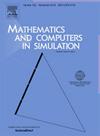HCV感染的空间异质性和扩散驱动动力学:一个数学模型框架
IF 4.4
2区 数学
Q1 COMPUTER SCIENCE, INTERDISCIPLINARY APPLICATIONS
引用次数: 0
摘要
体内丙型肝炎病毒(HCV)感染不仅包括病毒对细胞感染,还包括细胞对细胞感染。这种感染会刺激机体产生细胞毒性T淋巴细胞(CTL)免疫反应和抗体免疫反应。本文研究了包括空间扩散和内环境异质性在内的两种感染和两种免疫模型的疾病动态,进一步探讨了空间异质性对丙型肝炎病毒(HCV)灭绝和持续的影响。我们定义了基本繁殖数,推导了基本繁殖数R0的相应表达式,并证明了基本繁殖数R0可以作为病毒是否存在的阈值。即如果基本繁殖数R0<;1,则全球无病平衡稳定,HCV灭绝;如果基本繁殖数为R0>;1,则至少存在一个局部平衡,HCV将持续存在。此外,我们还进行了数值模拟,以研究空间扩散和异质性如何影响疾病动力学。结合理论分析和数值模拟,我们的研究结果表明,空间异质性可以增加宿主内病毒感染的风险。然而,受感染细胞和病毒的流动性可能有助于减少这些风险。本文章由计算机程序翻译,如有差异,请以英文原文为准。
Spatial heterogeneity and diffusion-driven dynamics of HCV infection: A mathematical modeling framework
Hepatitis C virus (HCV) infection in the body includes not only virus-to-cell infection, but also cell-to-cell infection. This infection will stimulate the body to produce cytotoxic T lymphocyte (CTL) immune response and antibody immune response. In this paper, we study the disease dynamics of two kinds of infection and two kinds of immune models, which include spatial diffusion and heterogeneity of internal environment, and further explore the influence of spatial heterogeneity on the extinction and persistence of hepatitis C virus (HCV). We defined the basic reproduction number, deduced the corresponding expression of the basic reproduction number , and proved that the basic reproduction number can be used as the threshold of whether the virus exists or not. That is, if the basic reproduction number , the disease-free balance is globally stable and HCV is extinct; if the basic reproduction number , there is at least one local equilibrium, and HCV will persist. Furthermore, we performed numerical simulations to investigate how spatial diffusion and heterogeneity affect disease dynamics. Combining theoretical analysis with numerical simulations, our findings reveal that spatial heterogeneity can increase the risk of viral infection within the host. However, the mobility of infected cells and viruses may serve to diminish these risks.
求助全文
通过发布文献求助,成功后即可免费获取论文全文。
去求助
来源期刊

Mathematics and Computers in Simulation
数学-计算机:跨学科应用
CiteScore
8.90
自引率
4.30%
发文量
335
审稿时长
54 days
期刊介绍:
The aim of the journal is to provide an international forum for the dissemination of up-to-date information in the fields of the mathematics and computers, in particular (but not exclusively) as they apply to the dynamics of systems, their simulation and scientific computation in general. Published material ranges from short, concise research papers to more general tutorial articles.
Mathematics and Computers in Simulation, published monthly, is the official organ of IMACS, the International Association for Mathematics and Computers in Simulation (Formerly AICA). This Association, founded in 1955 and legally incorporated in 1956 is a member of FIACC (the Five International Associations Coordinating Committee), together with IFIP, IFAV, IFORS and IMEKO.
Topics covered by the journal include mathematical tools in:
•The foundations of systems modelling
•Numerical analysis and the development of algorithms for simulation
They also include considerations about computer hardware for simulation and about special software and compilers.
The journal also publishes articles concerned with specific applications of modelling and simulation in science and engineering, with relevant applied mathematics, the general philosophy of systems simulation, and their impact on disciplinary and interdisciplinary research.
The journal includes a Book Review section -- and a "News on IMACS" section that contains a Calendar of future Conferences/Events and other information about the Association.
 求助内容:
求助内容: 应助结果提醒方式:
应助结果提醒方式:


